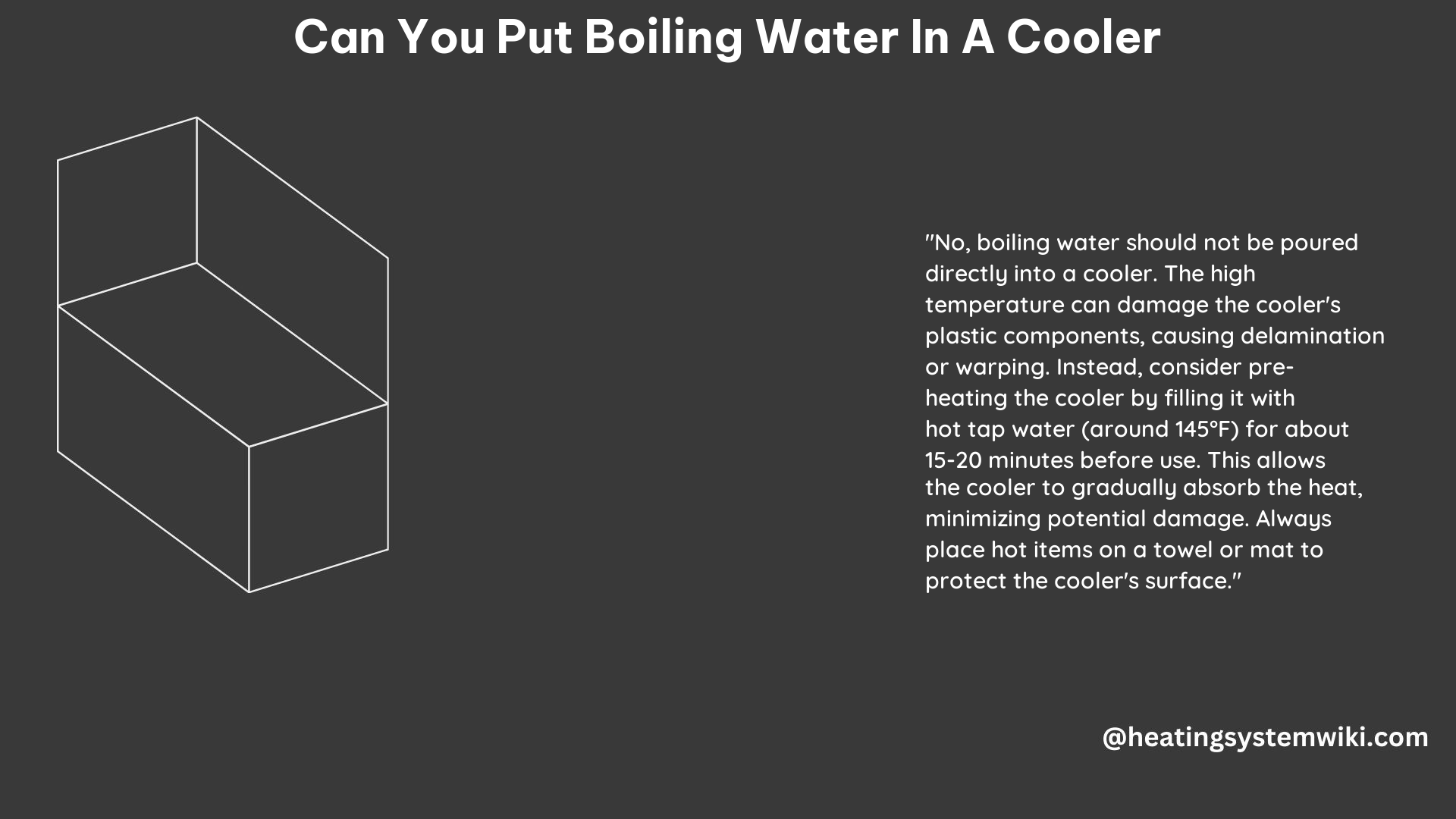Can you put boiling water in a cooler? The answer is yes, but with some important considerations and technical specifications to keep in mind. While it is possible to transport boiling water in a cooler, it is crucial to understand the limitations and potential risks involved to ensure safe and effective use.
Understanding Cooler Materials and Durability
When it comes to putting boiling water in a cooler, the material composition of the cooler is a critical factor to consider. Most standard coolers are made of plastic, which can degrade and become compromised when exposed to prolonged high temperatures.
| Cooler Material | Durability with Boiling Water |
|---|---|
| Plastic | Moderate to low durability, can degrade over time |
| Stainless Steel | High durability, can withstand boiling water |
| Rotomolded | High durability, designed for extreme temperatures |
It is recommended to use a cooler made of high-quality, food-grade materials that are specifically designed to withstand exposure to boiling water. Stainless steel or rotomolded coolers are generally the best options, as they can maintain their structural integrity and prevent the growth of harmful bacteria like Salmonella and E. coli.
Insulation and Heat Retention

Proper insulation is crucial when transporting boiling water in a cooler. The cooler must be able to maintain the high temperature for a sufficient duration to ensure the water remains hot enough for its intended use.
Here are some key insulation factors to consider:
- Cooler wall thickness: Thicker insulation walls provide better heat retention.
- Insulation material: High-performance insulation like polyurethane foam or vacuum-insulated panels (VIPs) are more effective.
- Lid design: Tight-fitting, well-sealed lids help prevent heat loss.
- Pre-chilling the cooler: Cooling the cooler before adding boiling water can improve heat retention.
As a general guideline, a high-quality, well-insulated cooler can maintain the temperature of boiling water (212°F/100°C) for up to 4-6 hours, depending on the specific model and environmental conditions.
Preparing the Cooler for Boiling Water
Before using a cooler to transport boiling water, it is essential to ensure the cooler is properly cleaned and prepared. Follow these steps:
- Thoroughly clean the interior of the cooler with hot, soapy water and allow it to dry completely.
- Inspect the cooler for any cracks, damage, or signs of wear that could compromise its integrity.
- Ensure the lid and seals are in good condition and provide a tight, secure closure.
- Consider pre-chilling the cooler by filling it with hot water and letting it sit for 30 minutes before draining and adding the boiling water.
Proper preparation helps minimize the risk of bacterial growth and ensures the cooler can effectively maintain the temperature of the boiling water.
Filling the Cooler with Boiling Water
When adding boiling water to the cooler, take the following precautions:
- Use caution to avoid burns or spills, as the water will be extremely hot.
- Fill the cooler to the top to minimize air space and improve heat retention.
- Avoid opening the lid unnecessarily, as this can cause significant heat loss.
- Monitor the temperature of the water periodically to ensure it remains at a safe, usable level.
It’s important to note that even with a well-insulated cooler, the boiling water will gradually cool over time. The rate of cooling will depend on factors such as the cooler’s insulation, ambient temperature, and the volume of water.
Potential Risks and Safety Considerations
While it is possible to transport boiling water in a cooler, there are some potential risks and safety concerns to be aware of:
- Cooler material degradation: Prolonged exposure to boiling water can cause plastic coolers to degrade, potentially leading to the release of harmful chemicals or the creation of breeding grounds for bacteria.
- Scalding hazard: Handling a cooler filled with boiling water poses a significant risk of severe burns and scalding injuries.
- Bacterial growth: If the cooler is not properly cleaned and sanitized, the warm, moist environment can promote the growth of harmful bacteria like Salmonella and E. coli.
- Reduced water temperature: Even with a well-insulated cooler, the boiling water will gradually cool, potentially falling below safe temperature thresholds for certain applications.
To mitigate these risks, it is crucial to use a cooler made of appropriate materials, maintain proper insulation, and follow safe handling procedures. Additionally, it is recommended to monitor the water temperature closely and plan for the gradual cooling of the water during transport.
Conclusion
In summary, while it is possible to put boiling water in a cooler, it is essential to carefully consider the technical specifications and safety factors involved. By using a high-quality, well-insulated cooler made of durable, food-grade materials, and following proper preparation and handling procedures, you can safely and effectively transport boiling water for a variety of applications.
Remember, the key to success is understanding the limitations of your cooler and taking the necessary precautions to ensure the safety and effectiveness of your boiling water transport.
References:
– Reddit Discussion on Putting Boiling Water in a Cooler
– Cooler Corn Safety Considerations
– Homebrewing Forum Discussion on Boiling Water in Igloo Cooler
– Egghead Forum Discussion on Boiling Water in Yeti Cooler
– Reddit Discussion on Boiling Water in Yeti Cooler
